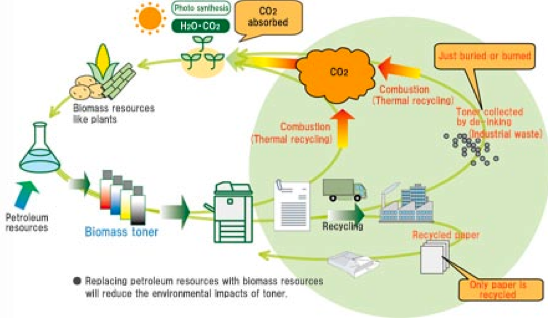 Ricoh has developed a technology to use biomass as a raw material for resin, the primary element of toner. This technology will lessen the environmental impacts of toner use—it will suppress the depletion of petroleum and reduce CO2 emissions through carbon-neutral processes.
Ricoh has developed a technology to use biomass as a raw material for resin, the primary element of toner. This technology will lessen the environmental impacts of toner use—it will suppress the depletion of petroleum and reduce CO2 emissions through carbon-neutral processes.
When used copy paper is recycled, the paper goes through a de-inking process, which separates the printed toner from the paper. The separated toner is then merely disposed of—it is either burnt or buried in landfills. Today's technologies are incapable of recycling the toner printed on paper.
Every year, more than 200,000 tons of toner is produced worldwide. About 80% of that amount is resin. To lessen the environmental impacts of toner, Ricoh has been developing biomass toner (*1), for which we adopted plan-based resin.
The biomass toner requires less petroleum than conventional toner, and contributes to the prevention of petroleum depletion. Being carbon-neutral, the biomass toner works to reduce the net amount of CO2 emitted from the combustion of used toner.
In November 2009, Ricoh released the world's first digital multi-function copier featuring biomass toner, the "for E toner." (This product is sold only in Japan.)
(*1) Biomass resources are organic resources that are biologically reproducible, excluding fossil resources.
Low-temperature fixing and heat resistance—two contradictory features implemented
Toner must meet a variety of characteristic requirements. To reduce the power consumption of a copier, the power required for thermal fixing must be reduced. This, in turn, requires the toner to be molten at a low temperature. However, toner with a low melting point has its own problems—it tends to coagulate when stored under a high temperature, for instance. In this way, low-temperature fixing and heat resistance hinder each other. This dilemma can be solved depending on the characteristics of binder resin.
Plant-based resins have been widely used for molding, but their characteristics are far from those required for toner resins. Ricoh has thus developed a new plant-based resin for use as toner binders. It is already in use as part of the binder for our biomass-based "for E toner."
The biomass content of the "for E toner" is 25% (*2). While meeting the requirements of both low-temperature fixing and heat resistance, the "for E toner" has the same high performance as our petroleum-based toner. With the excellent chargeability and fluidity, the "for E toner" has even attained a higher image quality than conventional toner.
(*2) Ricoh uses the biomass content, in percentage, to indicate how much biomass is contained in parts.
To steadily establish technologies and know-how
Ricoh has been examining many possibilities to reduce the environmental impact of toner, and considers the use of biomass effective at this point. It would be too late if we started developing biomass toner after the seriousness of global warming and petroleum depletion became clear. In the area of the conventional toner, Ricoh has many proven technologies, acquired over a very long time. We need to acquire the same technologies for the biomass toner, too.
Ricoh has made an early start in using the biomass toner in actual products. Ricoh will continue accumulating technologies and know-how on the biomass toner in preparation for the full-scale operation in the future, intending to contribute to preserving the environment.





























































































